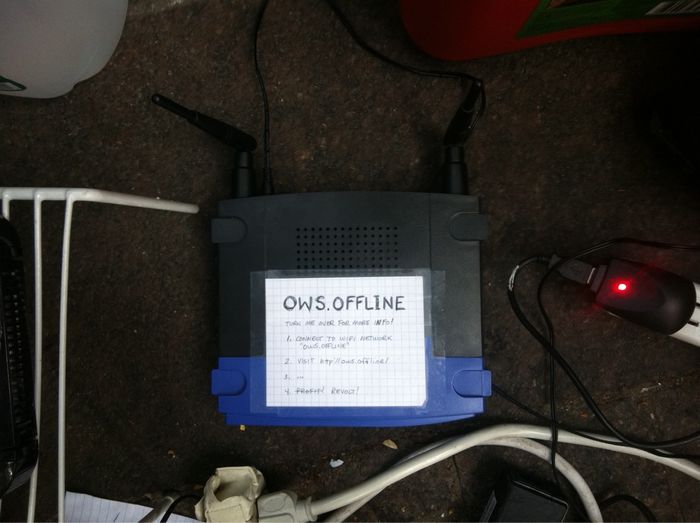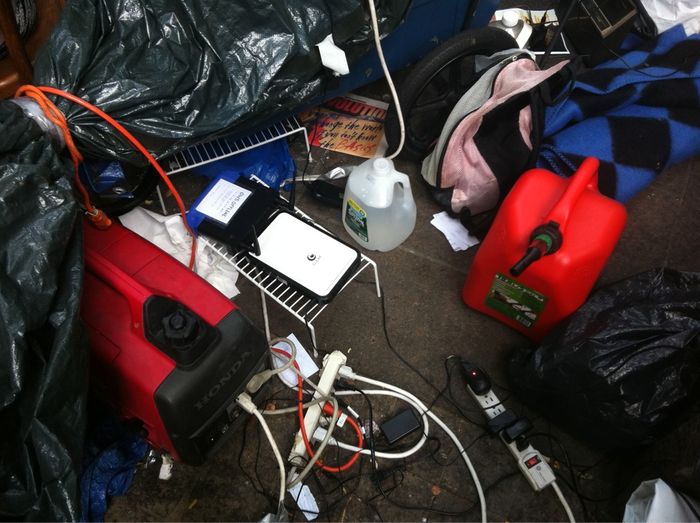Here is a presentation I gave about my project occupy.here at Future Archaeology’s first Open House event, The Sum of its Parts.
ows.offline in the (non-Occupied) Wall Street Journal
This afternoon I hung out for a few hours at the Occupy Together Meetup. I met some smart developers, made a few tweaks to the code, and spoke to a reporter from the Wall Street Journal. I’m hoping to also get this in the Occupied Wall Street Journal, which I’m guessing gets read by more people in Zuccotti Park.
ows.offline code released
I’ve finally set up a GitHub repository! It also includes some documentation on how to configure OpenWRT to behave like a captive portal. I’m trying to think of a better fake-TLD than “.offline”. Dot-occupy? I’m open to suggestions.
Update: I’ve renamed the project to occupy.here! More soon…
Hacking the WRT54GL
I’ve proposed a course at The Public School: Hacking the WRT54GL.
Lately I’ve been doing some projects that involve serving tiny self-contained websites on autonomous Linksys WRT54GL routers running OpenWRT. That is, websites you can only access by connecting to a specific wifi signal. In a creative sense I like the notion of giving web pages a physical presence, of focusing on a particular audience in a particular place. The technology is also pretty fun to work with.
ows.offline is um... online!
This morning I stopped by Zuccatti Park and left the wifi router running ows.offline! It seems that weekday mornings are a lot less crowded, and the people I met who were awake and in the park were exactly the people who I wanted to know about the project. I chatted with some folks at the info desk and they were really enthusiastic about the idea! I explained the idea to this one guy who promptly plugged me into the generator and said “you are awesome!”
I’m just going to play it by ear and just drop in for maintenance/backups and promotion when I can.

The label reads:
- Connect to wifi network “ows.offline”
- Visit http://ows.offline/
- …
Profit!Revolt!

Code release and promotional flyers coming soon!
Proposal for ows.offline
Occupy Wall Street
Like many New Yorkers I’ve been observing and processing the occupation of Zuccatti Park with a sense of cautious enthusiasm. It took me a few days to figure out what it’s actually about, and I’ve come around to accept their position that protesting with no stated agenda is legitimate. Here are some resources I’ve found useful, but really the best way to get a sense for things is to walk around and talk to people in the park.
- Ezra Klein’s interview with David Graeber
- “We Are All Human Microphones Now”
- The Public School: Learning From Occupy Wall Street, meeting again next Sunday
- McKenzie Wark on Occupy Wall Street: ‘How to Occupy an Abstraction’
In short, there are two separate things happening:
- The occupation itself (also): a group of activists with a range of leftist politics (plus some Ron Paul supporters) are using occupation as a tactic
- The New York City General Assembly: an experimental process of political deliberation and decision making is being used to guide the occupation
One challenge I’ve been working through is how to best express my sympathy for the occupation without bailing on my existing responsibilities. My Fall schedule has been really busy, which has made it especially difficult to participate.
Of course there are a variety of things one can do to show support and I’m hoping to contribute in a way that plays to my strengths. Below is a project proposal I’ve submitted to the Occupennial art exhibition (more info).
ows.offline proposal
I’ve been working on hacking a Linksys WRT54GL wifi router to run very simple web forum software I developed. It’s part of an art process that I’m calling Situated Net Art. Like other instances of net art it relies on web technologies such as HTML, but is intended to be experienced from a specific physical location rather than adopting the more universal context of the World Wide Web.
The motivation behind ows.offline is that the web offers a fantastic array of communication tools, but often the conversation suffers from certain trade-offs as the number of participants rises. Proximity could be a useful filter for those with the greatest need for better communication tools. The forum is an attempt to complement the existing deliberative process of the NYC General Assembly and offer its constituents a text-based forum to hash out their ideas with greater subtlety.
Another component I’m interested in exploring is how access to the necessary hardware is or is not available to occupiers. I would like to develop some kind of social contract that stipulates the laptop or smartphone being used to access the forum might be lent to those without access. A similar type of arrangement was used in Heath Bunting’s BorderXing database, where users of the site must agree to become internet providers in a kind of peer-to-peer distributed net cafe.

Photo courtesy of Flickr user shankbone
What next?
I’m not sure an art context is the best way to pursue this, but at least it’s a process I’m familiar with. I’m still pretty uncertain about the logistics of maintaining electricity and shepherding my little wireless router through the chaos of the plaza. Perhaps inclusion in an art exhibition is a way to keep the hardware safe and dry. The software itself is already written, I’m just trying to figure out the best way to deploy it. I’ll release the software soon on GitHub with instructions on how others might use it with their own wifi routers.
Of course I’m open to feedback, so please feel free to comment below.